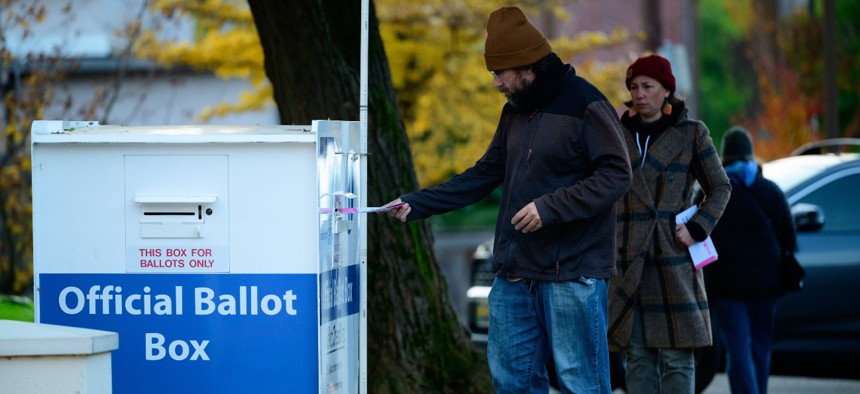USPS Reminds Employees to Continue Rushing Ballot Delivery Through November
A look at all the special steps USPS has taken, and will continue to take, to get ballots to election officials on time.
U.S. Postal Service management on Wednesday reminded employees that the “extraordinary measures” it has taken in the runup to the midterms must continue for three more weeks as the agency seeks to deliver late arriving ballots to election offices in time to be counted.
Those special steps, which USPS typically implements around election seasons, will remain in effect through Nov. 29. The measures include extra deliveries and collections, special pickups, expanded hours at processing plants, mail sorting plans to expedite ballot deliveries and the removal of some ballots to bypass normal processing to allow for local turnaround.
Many states allow for ballots to arrive at election offices well after Election Day, provided they were placed into the mail on or before Nov. 8. With dozens of federal races around the country still too close to call, those late-arriving ballots could make the difference in who emerges victorious. USPS management said in a message to employees Wednesday that they must “make every effort, including taking extraordinary measures, to deliver remaining undelivered ballots to the appropriate board of elections as quickly as possible and no later than the applicable extended deadline.”
In an earlier memorandum to supervisors, USPS authorized the use of overtime as needed to fulfill its election mail policies. It also allowed for the use of late and extra mail transportation trips if necessary to “connect election mail to its intended destination or the next stage in Postal Service processing.”
“The U.S. Postal Service is fully committed to the secure and timely delivery of the nation’s election mail,” Marti Johnson, a postal spokesperson, said on Tuesday. “We continue to process and deliver a large number of ballots, employing a robust and proven process to ensure proper handling of all election mail, including ballots.”
Postal management agreed to continue taking the same extraordinary measures it had in place in 2020 as part of a settlement agreement with the NAACP and Public Citizen and will do so for each election through at least 2028. At post offices, supervisors could extend hours and deploy personnel to postmark ballots. Letter carriers were required to check every mailbox for outgoing mail, even if they had nothing to drop off in them. USPS made collections from blue drop boxes on Sunday, which it usually does not do, and sent them out by 10 a.m. on Monday. On Monday and Tuesday, facilities were required to take special trips to local boards of elections to drop off ballots. Local postmasters will continue coordinating those drop offs until the last day each state accepts mail ballots.
USPS told processing plant employees that “special attention must be paid” to the states their facilities serve so they can pull out and deliver ballots by cutoff times. It also told its workers to “familiarize themselves with the specific requirements” in their states so the appropriate steps can remain in place until the ballot arrival deadline.
Unlike in 2020, USPS has not released real-time data on its ballot delivery performance. It did so in the last election only under court order as part of ongoing litigation and a spokesperson said it would not make that information public this time around until mid-December. During the primary season, the Postal Service delivered 99.33% of ballots from voters to election officials within three days. Ballots took an average of less than two days to get both from and to voters. Those figures marked an improvement over 2020 despite the number of mailed ballots increasing by 200% compared to the previous midterms in 2018.
In October, postal officials said they were reaping the rewards of their year-round dedicated election teams, improved relationships with election administrators and other initiatives. Even before the extraordinary measures went into effect, the Postal Service implemented trainings for field staff, daily “all clears” to ensure no ballots are left behind, log sheets for facilities to track election mail and a website for voters and election officials to report any problems. Its joint election task force, established with representatives from postal unions and associations, have ballot monitors and ambassadors who ensure the proper steps are being followed and that employees are aware of their responsibilities.
“The Postal Service is using our longstanding, proven processes and procedures to securely and efficiently deliver election mail,” said Johnson, the USPS spokesperson.








